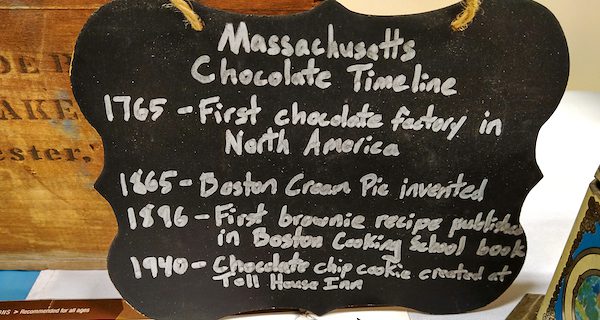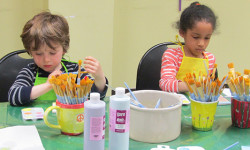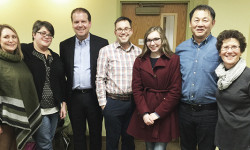Photos by Audrey Anderson
Boston’s chocolate firsts from 1765 to 1946
By Audrey Anderson
Hometown Weekly Reporter
At the Dover Public Library, on the evening of August 5th, Victoria Kichuk, a chocolate sommelier from Cocoa Beantown, gave an enlightening presentation about Massachusetts chocolate history to a small group of enthusiastic chocolate lov
Kichuk began by describing chocolate as a superfood. It is an anti-inflammatory that fights cancer, improves memory, and increases cardiovascular health. Of course, dark chocolate is the healthiest. Adding sugar and milk increases calories.
According to Kichuk, in early Boston, as in Europe at the time, chocolate, hot, or cold with milk, was a popular social drink for adults, alongside coffee and tea. Along with cafes and tea houses, chocolate houses were popular. The first chocolate house in Boston, owned by two women, was located in what is now Downtown Crossing.
The Baker Chocolate Company was established in Dorchester by John Hannon and Dr. Baker in 1765, as the first chocolate factory in North America. Hannon took charge of sourcing the chocolate in far-off lands, while Baker stayed at the factory to supervise production and ship orders. When Hannon was lost at sea, or, as what seems more likely, decided to abandon his life in Boston, his widow sold her interest to Baker, who took over the factory. Smaller chocolate factories sprung up around the Baker factory on the Neponset River, and the area became known as “chocolate town.”
At the time, as not everyone could read, the type of chocolate (or percent of cocoa included) was indicated by the color of the label. Hot chocolate was whisked in a specially designed chocolate pot, which was tall and narrow, with the spout located at the top, which allowed delicious chocolate foam to be sit on the top of every cup.
Boston was crazy for chocolate, and it became “the confectionary capitol of the world” for a time. Factories run by Necco, Charleston Chew, Junior Mints (made by Tootsie), and others were located in Cambridge.
Cooking schools and dining halls were added in Boston. The first was the Boston Cooking School, which began in the late 1800s. A famous student, Fanny Meritt Farmer, was interested in food for healing, as she had polio when young. She wrote a book of cooking lessons and recipes, so people who couldn’t get to the Boston cooking school could learn how to cook properly. She was the first to add precise measurements to recipes. Farmer paid for the first printing of the Boston Cooking School cookbook to get it started, and it never has gone out of print in over 100 years. In the cookbook, Farmer published the first recipe for brownies.
In 1938, Ruth Wakefield, owner of the Toll House Inn in Whitman, was responsible for another Massachusetts chocolate first. She was making butter drop cookies, when she discovered that she had run out of nuts. Looking around for a substitute, she found chocolate and cut it into pieces, thinking it would melt and make the cookies evenly chocolate. However, the chocolate pieces stayed whole in her new recipe, named Toll House Cookies, or chocolate chip cookies.
During her presentation, Kichuk passed around a bottle of seasonings generally added to drinking chocolate and a bowl of Equal Exchange minis to taste. Her display table was filled with interesting chocolate ephemera and collectibles that the attendees enjoyed perusing.






















